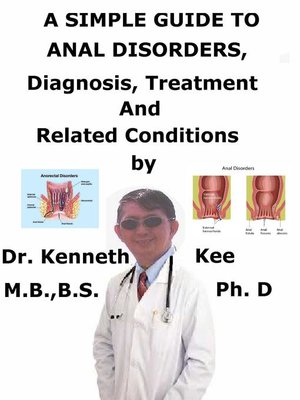
Sign up to save your library
With an OverDrive account, you can save your favorite libraries for at-a-glance information about availability. Find out more about OverDrive accounts.
Find this title in Libby, the library reading app by OverDrive.



Search for a digital library with this title
Title found at these libraries:
| Library Name | Distance |
|---|---|
| Loading... |
This book describes Anal Disorders, Diagnosis and Treatment and Related Diseases
The anus is that lowest part of the intestinal tract that passes through the muscular canal of the pelvis and anal sphincters.
It is the final opening (orifice) through which stool passes out of the body.
In adults, the length of the anus is 4 to 5 centimeters long.
The lower half of the anal canal has very sensitive nerve ends.
There are blood vessels under the lining, and in its middle section there are numerous tiny, anal glands.
Disorders of the anus are frequent.
They are hemorrhoids, abscesses, fistulas (tracts), fissures (cracks), and cancer.
The most frequent causes of Anal Disorders are:
1. Constipation
2. Chronic diarrhea
3. Hereditary factors
4. Excessive sweating in the area around the anus
5. Aging
Risk Factors for Anal Disorders
These factors may raise the likelihood of Anal Disorders:
1. High daily salt intake
2. History of diabetes
3. Hyperlipidemia (high lipids in blood)
4. Suffering from dermatitis
5. History of anorectal surgery
6. History of smoking and alcohol intake
7. Sedentary lifestyle
8. Excessive intake of spicy food
9. Prolonged sitting on the toilet for defecation
Symptoms of Anal Disorders are indicative of Anal Disorders:
1. Pain in the perianal area
2. Constipation
3. Drainage from the rectum
4. Fever
5. Chills
6. Palpable mass near the anus
7. Itchiness
8. Burning sensation
9. Pus discharge
10. Blood
11. Diarrhea
12. Swelling in around the rectum and anus
While all anal disorders produce some type of anal discomfort or pain, other symptoms differ, depending on the specific anal disorder.
For anal fissure, symptoms may be:
1. Pain in the anal area, often described as sharp, searing or burning, and normally activated by a bowel movement
2. Mild rectal bleeding, typically a small amount of bright red blood with a bowel movement or on the toilet paper.
For anal abscess, symptoms are:
1. A firm, tender mass or swelling in or around the anal area
2. Occasionally fever, chills and a generally sick feeling.
For an anal fistula, symptoms may be:
1. Mild pain around the anus, centered in a region where an old anal abscess has either drained spontaneously, or has been opened surgically by a doctor
2. Persistent drainage of blood, pus or foul-smelling mucus from the anal area.
3. Symptoms of a recurrent anal abscess which may develop if the external opening of the fistula becomes clogged and the old abscess reactivates
For thrombosis of an external hemorrhoid, the symptoms are:
1. A firm and normally quite painful swelling at the anal orifice
2. Occasionally bloody discharge, if the surface of the hemorrhoid breaks down.
Procedures for Treatment of Anal Disorders are:
1. Surgical excision: To control pain
2. Rubber band ligation: To decrease the amount of redundant tissue
3. Sclerotherapy: To increase fixation of the hemorrhoid tissue to the wall of the rectum
4. Infrared coagulation: To decrease vascularity
5. Hemorrhoidopexy: To fix the anal cushions in place and resect the tissue
6. Hemorrhoidectomy: To remove hemorrhoids
7. Sphincterotomy: To treat anal fissure
8. Incision and drainage: To prevent spread, recurrence, and subsequent fistulization
9. Sacral nerve stimulation: Improves squeeze pressures of the anal sphincter and rectal sensation
While it is not always possible to prevent other types of anal disorders, the patient may be able to...







